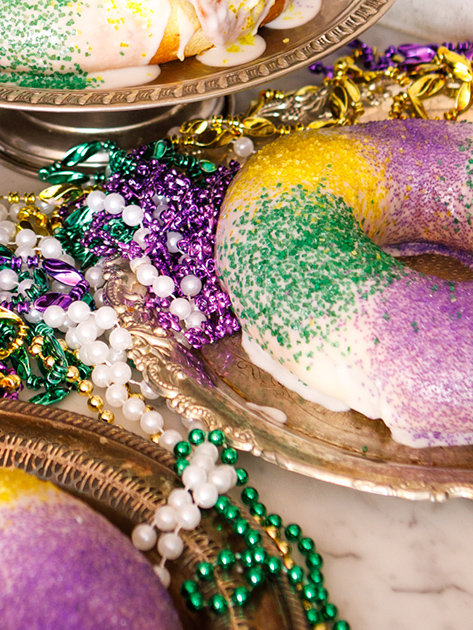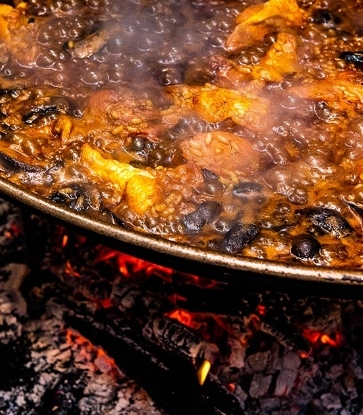“A good ma lai gao should be soft and fluffy, but not sticky. You can separate the great from the good by looking at the skin—excellent ma lai gao should have what we call the 'Qilin pattern'—marks like leopard stripes—on the surface, a sign that the cake was made by a seasoned master,” says chef Wong Yiu-Por, executive dim sum chef of China Tang in Hong Kong.
Ma lai gao is a ubiquitous treat in Hong Kong. Listed on the menu in almost every dim sum restaurant, it is most enticing when served steaming hot. Few can resist the humble yet comforting fragrance and flavor that come along with a golden skin and airy texture.
British Roots
The origins of this dim sum favorite though, could lie far outside of Hong Kong. Its roots are disputed, but the most common story is that the cake originated from the British who brought their afternoon tea cakes to the Malayan peninsula.
The Malaysians then changed up the sponge cakes, replacing milk with coconut milk, adding pandan leaves, and had them steamed instead of baked.
Later, Cantonese chefs brought this modified cake to Hong Kong, took away the non-indigenous pandan leaves, and it evolved into this iconic cake with the name 'ma lai,' meaning "Malaysia" in Cantonese.
Hong Kong’s National Cake
CNN drew the global spotlight on ma lai gao when it named it Hong Kong's national cake, alongside other sweet bakes like tiramisu for Italy and Germany's Black Forest cake.

Chef Wong, who has worked in dim sum kitchens for half a century, approves of the accolade: “Har gow (shrimp dumpling), siu mai (pork dumpling), steamed beef balls and char siu bao (steamed barbecued pork bun) are always the best selling items, and the popularity of ma lai gao comes right behind them. The cake is, indeed, loved by many.”
The Challenge Is in the Levain
The main ingredients of ma lai gao are fairly basic: flour, eggs, sugar, milk and levain, a mixture of flour and water that has been converted into a leavening agent through the process of fermentation.
Making the levain presents the biggest challenge; if you are new to cooking, expect unsatisfactory first attempts. Some might be tempted to replace levain with baking soda—Wong doesn't recommend this shortcut. "The time and effort put into making levain is totally worth it, as it enhances the smoothness and chewiness of the cake.”
Each restaurant has its own recipe: "Restaurants have always adjusted their style according to their customer base," he adds. "For example, those near the markets, where there are more blue-collar workers, make sweeter cake; restaurants in Central and Tsim Sha Tsui, in contrast, make them milder."
One interesting habit in communal ma lai gao consumption is that people tend to choose the "rim" of the circular cake and avoid the center. Why? "The center is often the cake's thickest part, and probably not as fluffy as the rim. Personally, I don't have a preference, I am happy to eat both," laughs Wong.
These days you can find many innovative variations of ma lai gao: some adding corn for texture, replacing granulated sugar with brown sugar to alter the flavor, or even turning it into a sandwich cake by adding a layer of custard in the middle. However, if you like the original ma lai gao, here is chef Wong's step-by-step recipe to walk you through the process.

Ma Lai Gao
Recipe courtesy of Chef Wong Yiu-Por, China Tang, Hong KongIngredients
500 grams levain (recipe below)
500 grams granulated sugar
38 grams custard powder
38 grams milk powder
38 grams all-purpose flour
500 grams whole eggs
30 milliliters baking soda solution
250 milliliters vegetable or peanut oil, plus more for coating
23 grams aluminum-free baking powder
Baking parchment
Three 8-inch steamers
Method
1. Add the sugar, custard powder, milk powder and flour into the levain; mix by hand.
2. Whisk the eggs and divide into 4 portions. Add each portion to the levain mixture, mixing well, until the sugar has completely dissolved and batter is smooth and slightly thick before adding the next portion.
3. Cover the batter with a wet towel and pan, and leave in a cool, dry place for 24 hours.
4. Mix the baking soda solution into batter.
5. Heat 30 milliliters of oil in another bowl to a temperature of 20°C to 30°C and mix with the baking powder until smooth. Add the rest of the oil.
6. Pour the baking powder mixture into batter and mix well.
7. Line each steamer with baking parchment and coat with some oil. Divide the batter among the prepared steamers. Steam for 20 minutes on high heat. Serve immediately.
Levain
Ingredients
600 milliliters water
400 milliliters beer
2 kilograms cake flour
Oil, for greasing
Method
1. Combine 150 milliliters water, 100 milliliters beer and 500 grams flour and mix until the dough is no longer sticky.
2. Transfer dough to a greased deep pan and cover with a wet towel and another pan. Leave in a cool, dry place for 24 hours to rise.
3. Take half of the risen dough; add 150 milliliters water, 100 milliliters beer and 500 grams flour and mix until the dough is no longer sticky. Repeat step 2.
4. Compare the two batches of risen dough: if the second batch is more fragrant and softer in texture, fermentation is going well. Take half of the second dough; add 150 milliliters water, 100 milliliters beer and 500 grams flour and mix until the dough is no longer sticky. Repeat step 2.
5. Compare the third batch of dough with previous ones in the same way. If it's good, take half and add the rest of the ingredients and mix until the dough is no longer sticky. Repeat step 2.
6. Use 500 grams of the dough that has risen 4 times for the ma lai gao.
To store the levain: Wrap the rest in cling film and place in airtight container. Put the container inside the refrigerator and let it age (it can last around 10 days). To use again, take out half of the stored dough. When it reaches room temperature, add 500 grams flour and 200 milliliters water. Let it rise for 24 hours. Use 500 grams for making another batch of mah lai gao.
This article was written by Mandy Li. Click here to read the original story.






















